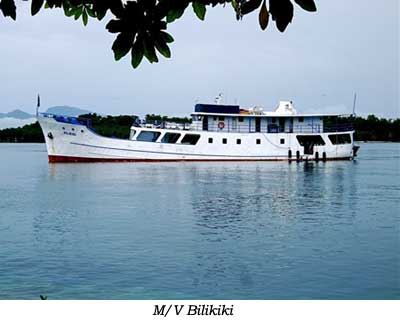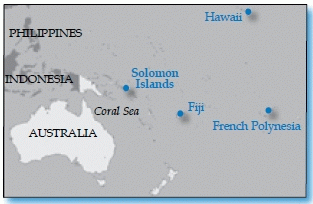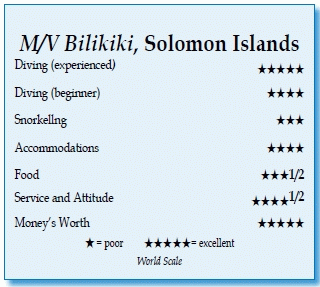M/V Bilikiki, Solomon IslandsContents of this Issue: Our Book Pick This Month: Ocean Soul British Virgin Islands, Utila, Raja Ampat Integrated Weights Vest: Helpful or “a Piece of Junk”? Should You Splurge on an VO2 Max Test? Where’s That Sound Coming From? More Marine Species on the Brink 189 Failures Lead to Recall of 17,000 Miflex Hoses Taking Kids on Your Next Dive Trip Editorial Office: Ben Davison Publisher and Editor Undercurrent 3020 Bridgeway, Suite 102 Sausalito, CA 94965 fishy reefs and WWII wrecks from the May, 2012 issue of Undercurrent
Dear Fellow Diver: Jet lag does nothing for attitude enhancement. So when I travel from the U.S. for a full day or more, my annoyances are magnified. After the flight to Fiji, then on to Honiara, I and 10 other divers arriving on the same flight had to hang around the Honiara Hotel from 10 a.m. to 4 p.m., before being transported to the Bilikiki. Assured by the pleasant office manager that he would look for us around 4 p.m. for pickup, I roamed the muggy open-air lounge and the cooler restaurant, then settled into a lounge chair in the shade overlooking the harbor. A birthday bunch of children laughed loudly and peed in the pool. Unable to nap and knowing I had to pass time for 90 minutes more in my travel malaise, I ordered lunch and read a book. At 3 p.m., I looked around and saw that my 10 companions were missing. When I asked at the desk, I was told they had left for the Bilikiki. In a slight panic after I discovered the phone numbers listed in my paperwork did not answer, I sought aid from a hotel staff member, who went to the beach and flagged down one of the Bilikiki's tinny drivers, and I was soon on board. Without an apology, cruise director Kellie graciously gave me the briefing, and I set up my tank. Cocktails on the upper deck before dinner adjusted my attitude.
The Russell Islands host great caves, caverns and swimthroughs. At Custom Cave, three of us followed divemaster Sam though a 60-foot-long tunnel that opened to a wide cave in which shimmering shafts of sun burst through. After exiting, Sam went his way, and I finned into one cave after another with gradually smaller openings. I spotted a comet in a crevice at a cave entrance; deeper within was a paddlefin cardinalfish. A larger crevice led inside the island to a pool of water opening on land; sunlight filtered through the trees on thick vines. At Bat Cave, I swam through a wide crevice for 50 feet before surfacing to view bats inside a cave. Seventeen self-absorbed divers popped up with their shining lights, disturbing the creatures. I dove deep to avoid being kicked by fins. At Leru Cut, I swam through a narrow passage, surfacing to find hanging vines and boulders with the filtered light. Magical.
Diving must be coordinated with each island's chief and elders, as their communities own the reefs through customary law. Early on, the Belmares gave them seeds to grow food other than papaya and bananas. Today, to feed us divers, the Belmares buy fruit, vegetables and fish from them, while passengers are potential buyers for the impressive carvings. In addition, there is an undisclosed monetary exchange and mutual support. One day while steaming toward a dive site, Sam responded to a village request to help locate a sunken boat that sunk, but the crew was unsuccessful. Undersea, Solomon's topography varies widely -- walls, valleys, bommies, caverns, caves, sandy bottoms, and plenty of colorful soft and hard corals, including a field of giant sea fans. Tropical fish and critters abound, including the more esoteric types. Visibility varied between 10 and 100-plus feet because it is a nutrient-rich environment, often with lots of "stuff" floating. Water ran about 86 degrees, similar to daytime temperatures. Wrasse flaunted the vast quantity of species in their family: wedge-tailed; whitepatch razorfish (juvenile, deep reddish-brown); bird and sharpnose. I spotted a tiny, greenish-yellow fish erratically darting about -- a juvenile whitespotted wrasse -- then found it in the initial and terminal phases. I often saw spadefishes (batfish to some), mostly large groups of golden and longfin. Crocodile flatheads blended in well with the sand and rubble. I occasionally saw sharks and turtles, bumphead parrotfish, Napoleon wrasse and eagle rays. I found pygmy seahorses at several sites, and joined in spirited competition with other divers to find all seven of the Solomons anemonefish species. Led by their good-natured captain, the Bilikiki crew maintained a high level of service and safety. They were friendly, respectful and professional -- never in our faces but always ready to assist. The Belmares show them respect by having the stern's upper deck set aside for crew use only. The friendly manager/ dive instructor duo of Sam and Kellie were always around between dives, joined us for sunset viewing and ate meals with us. They made diving easy, loading the gear each day on their two stable tinnies, and helping me in and out from the mother boat. When I was geared up and seated on the stern's water-level loading platform for a solo dusk or evening dive, one of them was ready to give a firm push on the back for a face-plant to avoid the tank hitting the platform. The dive deck provided ample space for suiting up. Rinse tank water was changed daily, with a chemical added to kill the plankton that die in wetsuits' minuscule nooks and crannies, and stink up the place. In the lounge space was a large table for working on cameras, while the charging station was on the upper deck. More than half of the divers had underwater cameras, a few with strobes. I was ready to punch a certain diver who banged into me underwater many times with his dual strobes. Of course, this guy had to get into just the right position, even if it meant damaging coral. Dive sites were usually just a minute or two tinnie ride. There were no buddy-dive rules, only a suggestion to limit dives to one hour when the boat was going to move; otherwise, it was between you and your computer. Kellie or Sam checked the site before briefing, and one always dived to spot critters for those who cared to follow. At dive's end, I would hand up my weights and tank, and climb the tinnie's sturdy metal ladder. After each dive, I went to the upper sundeck and ensconced myself in the lone hammock, replaying the dive in my mind for 15 minutes. Afterwards, I visited the deck below, where popcorn, fruit or cookies were laid out.
I could choose to dive at 8 a.m., 11 a.m., 2 p.m., 5 p.m. and after dinner, around 8:30. By the time 5 p.m. rolled around, most divers chose to skip the night dive and took a drink to the upper deck to await sunset. One late afternoon, I went in for a dusk dive in calm waters, cloud cover, rain in the distance, and no current on the wall. Current around the point was strong, and I decided not to fight it; four dives had left me hungry. With my night dive light blazing, I exited alone to a black sky, strong wind, two-foot waves and heavy rain. One tinnie had been waiting along the wall, the other around the corner, and I was picked up instantly. The rain continued to pour throughout dinner, blowing under the windows' plastic drop-down coverings; those of us closest hustled inside. The vessel rocked for part of the seven-hour transit that night but it was mostly stable. With the exception of a twenty-something couple, we were a middle-aged group of experienced divers who were never short of stories. The USA led in numbers, along with divers from Australia, Canada and South Africa. This was the fourth trip for an older couple who never lagged in showing enthusiasm. One woman only snorkeled. She arrived with luggage filled with a treasure trove of gifts for the villagers, and refilled it with village crafts. We guests intermingled in the comfortable, covered lounge area mid-decks, at dinner at the three large tables on the adjoining deck, and on the upper deck for viewing scenery. Plenty of space and a lot of conviviality. Buffet meals were attractively displayed, with a plate of fresh tasty fruit -- banana, papaya, mango, starfruit and wonderfully sweet pineapple. Breakfast always included eggs (fried like rubber bricks), breads, pancakes or French toast (no syrup, just jams). Lunches were pizza, quiche, chicken wings or sandwiches, along with salads -- rice, sweet and flavorful tomatoes, slaw and bean. For dinners, soup, several salads and potato dishes accompanied the main course, which was good but generally bland. The roast pork for Sunday dinner was succulent. Fish in sauce was served a couple times, and crab joined the last meal. The three cooks were conscientious about providing vegetarian choices. Desserts were delicious profiteroles, flan and lime pie; ice cream was frequently available. John, the bartender, would mix a drink and pour out wine, or you could do it yourself and keep track. The cheapest bottle of wine was $20, or $5 by the glass; beer was $3.50, shots of liquor were $4. When I asked for a one-shot gin and tonic, I got two -- and was billed for it. Between afternoon dives, we visited four villages. At three of them, beautiful and intricate wood carvings were for sale at reasonable prices. Kellie and Sam advised that negotiations should be whispered close to their ears, so fellow carvers could not hear -- and don't insult their art with a ridiculously low bid. I bought an interesting, well-carved palm nut sculpture with turtles and fish. At the fourth village, we were presented with fragrant leis. Most of the thatched houses were on stilts, with a separate kitchen used by several families. Overall, we had two bust dives, not bad for a 10-day trip. Off the village at Peava Harbor, eight of us descended 20 minutes before dusk to await the mating ritual of the mandarinfish. We formed a loose circle around the twiggy hard coral and waited. Whenever there was movement, cameras flashed, blinding not only me but I assume the fish, too. After 40 minutes of immobility, I left without seeing the elusive mandarinfish. Still, most of us were game for manta-watching several days later. At Devil's Highway, we quietly waited for them to come sailing overhead. None came. To get in three dives on the last day, Sam offered a 5:30 a.m. dawn dive where we were anchored, Patrick's Beach in the Florida Islands. I was ready 20 minutes early, and two boat crew members magically appeared to put my tank in the tinnie. I was shuttled to a site near shore, backrolled, and reveled in being alone in the dark waters. Sam and another early-morning diver were brought to the area halfway though my dive. Sam spent his time searching and digging out crownof- thorns starfish. I surfaced to a brilliant sun and a sparkling rainbow. I couldn't see the tinnie in the glare, but it was upon me in 20 seconds. Our last dive of the trip was Anuha Island. The sandy bottom with widely interspersed bommies was full of delights. As I rounded one outcropping, I came head to head with a two-foot broadclub cuttlefish. After matching the grayish tan of the rock, the cuttlefish went through an array of color changes, from yellow to bluish purple to dark brown before finally settling back into its original color. As we continued our staring match, he came closer and reached out a tentacle toward my mask. After diving 75 minutes, it was time to end my wanderings undersea at the Solomon Islands. I spotted Kellie alone and hovering. I slowly approached and was treated to the view of two robust ghost pipefish, a reddish-brown variation, side by side and floating nose downward. What a final image of this great dive trip. -- J.D.
|

I want to get all the stories! Tell me how I can become an Undercurrent Online Member and get online access to all the articles of Undercurrent as well as thousands of first hand reports on dive operations world-wide
| Home | Online Members Area | My Account |
Login
|
Join
|
| Travel Index |
Dive Resort & Liveaboard Reviews
|
Featured Reports
|
Recent
Issues
|
Back Issues
|
|
Dive Gear
Index
|
Health/Safety Index
|
Environment & Misc.
Index
|
Seasonal Planner
|
Blogs
|
Free Articles
|
Book Picks
|
News
|
|
Special Offers
|
RSS
|
FAQ
|
About Us
|
Contact Us
|
Links
|
3020 Bridgeway, Ste 102, Sausalito, Ca 94965
All rights reserved.

 Ten days later, I had nothing but good diving memories.
For sheer coral
beauty adorning winding
canyons and reefs,
Kicha, a dive site in
Morova Lagoon, was a
standout. A few dozen
schooling barracuda
and a large white-tip
were in juxtaposition
to pygmy seahorses,
deep blue sea stars
and cushion stars. You
can't beat an awesome site, so we dived this one a second time.
Catching my attention were a group of
squarespot anthias, males painted magenta
with a blue square. An Indonesian pipehorse,
or its close cousin, was swimming
near a fan; I watched it gently curl its
tail to attach.
Ten days later, I had nothing but good diving memories.
For sheer coral
beauty adorning winding
canyons and reefs,
Kicha, a dive site in
Morova Lagoon, was a
standout. A few dozen
schooling barracuda
and a large white-tip
were in juxtaposition
to pygmy seahorses,
deep blue sea stars
and cushion stars. You
can't beat an awesome site, so we dived this one a second time.
Catching my attention were a group of
squarespot anthias, males painted magenta
with a blue square. An Indonesian pipehorse,
or its close cousin, was swimming
near a fan; I watched it gently curl its
tail to attach. The Bilikiki (the local word for sandpiper) is a well-maintained, bug-free,
older vessel that is 125 feet long and has a lot of character. She and her sister,
the Spirit -- out of commission for two years due to lack of business --
are the only liveaboards in the Solomons. Converted from a Taiwanese fishing
boat, the Bilikiki has been plying these waters since 1988 under the ownership of
Rick and Jane Belmare, who divide their time between Australia and Canada. Much
of the vessel has a bow-to-stern slope (from bed to bathroom in my stateroom),
but wall-to-wall carpet inside and out controls the potential slipperiness. Ten
staterooms accommodate 20 in comfortable bunk beds; my lower was a double-sized
bed. Guest rooms are below decks -- with slatted wood doors and no windows,
they're enough for privacy but not enough to keep out the sounds of your neighbors
talking and snoring, among other actions. Master-controlled air-conditioning
kept cabins at 75 degrees.
The Bilikiki (the local word for sandpiper) is a well-maintained, bug-free,
older vessel that is 125 feet long and has a lot of character. She and her sister,
the Spirit -- out of commission for two years due to lack of business --
are the only liveaboards in the Solomons. Converted from a Taiwanese fishing
boat, the Bilikiki has been plying these waters since 1988 under the ownership of
Rick and Jane Belmare, who divide their time between Australia and Canada. Much
of the vessel has a bow-to-stern slope (from bed to bathroom in my stateroom),
but wall-to-wall carpet inside and out controls the potential slipperiness. Ten
staterooms accommodate 20 in comfortable bunk beds; my lower was a double-sized
bed. Guest rooms are below decks -- with slatted wood doors and no windows,
they're enough for privacy but not enough to keep out the sounds of your neighbors
talking and snoring, among other actions. Master-controlled air-conditioning
kept cabins at 75 degrees. World War II history abounds. At the Florida Islands, I floated above
a nearly intact Japanese Mavis seaplane at 100 feet, and a debris field of
planes, boats, bombs, bottles, a tattered Japanese flag attached to a piece
of metal -- and pipefish galore. White Beach in the Russell Islands is an
eyesore, with jeeps, barges, pipes, tires and other WWII leftovers that were
unceremoniously pushed into the water around the island. (The Royal Australian
Navy is still clearing unexploded bombs.) But its marine life at this site did not disappoint: pajama cardinalfish,
eight-banded butterflyfish, needlefish,
morays, barramundi and a puzzling black
caengastropod snail with a fleshy shelless
appearance. When a cuttlefish laying
eggs noticed me, she deposited one
more, then calmly retreated five feet
to watch me. Back on board, I eagerly
watched the National Geographic DVD
Lost Fleet of Guadalcanal.
World War II history abounds. At the Florida Islands, I floated above
a nearly intact Japanese Mavis seaplane at 100 feet, and a debris field of
planes, boats, bombs, bottles, a tattered Japanese flag attached to a piece
of metal -- and pipefish galore. White Beach in the Russell Islands is an
eyesore, with jeeps, barges, pipes, tires and other WWII leftovers that were
unceremoniously pushed into the water around the island. (The Royal Australian
Navy is still clearing unexploded bombs.) But its marine life at this site did not disappoint: pajama cardinalfish,
eight-banded butterflyfish, needlefish,
morays, barramundi and a puzzling black
caengastropod snail with a fleshy shelless
appearance. When a cuttlefish laying
eggs noticed me, she deposited one
more, then calmly retreated five feet
to watch me. Back on board, I eagerly
watched the National Geographic DVD
Lost Fleet of Guadalcanal. Divers Compass: My 10-day trip cost me $3,880 . . . Airfare on
Air Pacific from LAX to Fiji was $1,200; from Fiji to Honiara via
Fly Solomons was $875 . . . I used Poseidon Dive Adventures to
set up the trip, and got burned on the inner-island flight leg;
I should have let Bilikiki set it up, as its reservations staff
knows the ins and outs of pricing in that area . . . I dived
nitrox, as did most of the divers, which cost $200 for the 10-day
trip, or $10 per tank. Website:
Divers Compass: My 10-day trip cost me $3,880 . . . Airfare on
Air Pacific from LAX to Fiji was $1,200; from Fiji to Honiara via
Fly Solomons was $875 . . . I used Poseidon Dive Adventures to
set up the trip, and got burned on the inner-island flight leg;
I should have let Bilikiki set it up, as its reservations staff
knows the ins and outs of pricing in that area . . . I dived
nitrox, as did most of the divers, which cost $200 for the 10-day
trip, or $10 per tank. Website: 